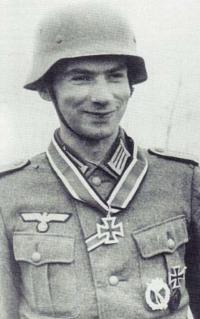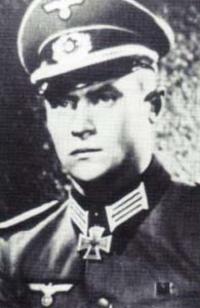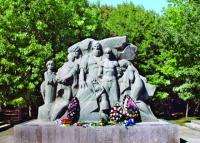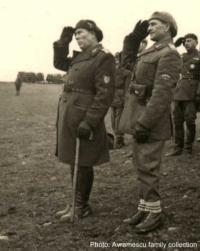This week, 70 years ago, German forces were driving south into the area between the Black and the Caspian Seas, which is known as the Caucasus. The quest was, as it is now, for oil. On August 9, 1942, the City of Maykop was captured. Today it is a city of 144,000 and is the capital of the Republic of Adygeya in the Russian Federation. The city is located on the Belaya River about 1,100 miles south of Moscow, east of the Black Sea and west of the Caspian Sea.
Maykop was the third largest petrol center in the Caucasus,70 years ago, which was itself rich in petroleum, a commodity desperately needed by the Axis to fuel their war machine. The oil fields at Maykop and Grozny produced 5,000,000 tons of petroleum a year. Before the 1942 campaign began, Hitler said, "If I cannot capture at least Maykop, I cannot fight on."
In October of 1941, der Führer had told Field Marshal Gerd von Rundstedt, commander of Army Group South, that his forces were to capture Maykop and Stalingrad - each hundreds of miles from the other - even though the Field Marshal protested that an advance of more than 400 miles from his present position would be required, leaving his left flank dangerously exposed. Hitler explained to the Field Marshal - the Wehrmacht’s senior, highest ranking and most respected, field commander - that the Soviets were finished and incapable of serious resistance. The Field Marshal laughed aloud.
The following spring, Army Group South - now without Field Marshal von Rundstedt, because he had been fired in November - was divided into Army Groups A & B. Army Group A, commanded by Field Marshal Wilhelm von List was now tasked with the capture of the Caucauses. Army Group A consisted of: I Panzerarmee, still commanded by Ewald von Kleist; 17th Army commanded by Richard Ruoff; and Third Romanian Army, commanded by Petre Dumitrescu.
The Defenders included the North Caucasian Front, commanded by Marshal Semyon Budyonny and the Trans-Caucasian Front commanded by Ivan Tyulenev.
The Red Army, unable to remove machinery and equipment quickly enough from the areas being occupied by the onrushing Wehrmach, began a scorched earth campaign, destroying everything. To counter this, the Germans sent in a Brandenburger unit, under the command of Lt. Baron Adrian von Fölkersam. The Brandenburgers were the Wehrmacht’s special operations troops. Equipped with Soviet trucks and dressed as NKVD soldiers, the Brandenburger’s approached the oil fields at Maykop. As they got near the target, they ran into a group of Soviet deserters. Baron von Fölkersam, who had been born and raised in the Russian Imperial capital of St. Petersburg, and so spoke fluent Russian, convinced the deserters to accompany him - rather than face the alternative as deserters from the Red Army. With them, he arrived at the Soviet headquarters in Maykop and convinced the Soviet Commander to give him a tour of the base. Using the knowledge gained of this tour, the Brandenburger’s were able to capture the base communications center and convince the Soviets they were there to withdraw.
Another Brandenburger unit, also dressed in Soviet uniforms and commanded by Lt. Ernest Prochaska and also traveling in captured Soviet trucks, advanced toward the strategically important bridge at Bjelaja and by yelling "Tanki, Tanki!" while gesticulating and looking terrified, convinced the Soviet defenders that these were Soviet troops in full retreat. The Soviet troops defending the bridge abandoned their positions and fled, allowing the Brandenburger’s to disarm the demolition charges. Both lieutenants were decorated with the Knight’s Cross - Prochaska posthumously.
A couple of days later, on August 9, Hellmut von der Chevallerie’s 13th Panzerdivision marched in and captured the city, the oil fields, 1000 prisoners and the base, without a shot being fired. Accompanying the division was an "oil salvage company," which, although it may have known something about oil production, knew little to nothing about combat, which didn’t serve it well when it encountered the Red Army. Felix Steiner’s SS Viking Panzergrenadier Division occupied the Muk refinery on August 14.
Also on August 9, 1942, General Rouff’s 17th Army occupied Krasnodar. It is located 50 miles east of the Black Sea and 620 miles south of Moscow. Located on the Kuban River, it has a population of 750,000. But, its refinery was destroyed.
Unfortunately, the capture of Maykop did not solve der Führer’s fuel problems. The Red Army had, in fact, sabotaged the wells, storage facilities and refineries. A bigger target - and even further distant - was Baku. Der Führer urged Field Marshal von List to scrape together all available forces for the final push to Grozny and Baku.
Today, Baku, a 2000-year-old city on the western shore of the Caspian Sea, with a population of 2,000,000, is the capital of Azerbaijan. Seventy years ago, it had a population of 800,000 and produced 80 percent of the Soviet Union’s oil. Its capture - no matter the condition of the oilfields - would have driven the U.S.S.R. from the war. Prior to the campaign, a cake had been presented to der Führer in the shape of a map of the Caspian Sea, with Baku spelled in chocolate. After eating the cake, Hitler told the assembled, "Unless we get Baku oil, the war is lost."
On August 25, tanks of von Kleist’s XXXX Panzerkorps, commanded by Geyr von Scheppenburg, were at Mozdok, 50 miles from Grozny, on the Terek River. The river was crossed on September 2.
Grozny is the capital of Chechen Republic of the Russian Federation, with a population of 271,000. Before the war, Chechnya had a population of about 700,000, of which 53 percent were Chechens and 29 percent were Russians. The Russians have always had trouble with the Chechens and 70 years ago was no different. Therefore, the Germans expected a lot of help, but it didn’t happen to the extent that the Germans thought would happen.
The Supreme Warlord relieved Field Marshal von List of the command of Army Group A on September 9. The Supreme Warlord replaced Field Marshal von List with himself - 1500 miles away! Three days later, Malgobek in Ingushestia was occupied. Today, it has a population of 31,000 and on October 8, 2007 was designated a "City of Military Glory."
On September 20, Eberhard von Mackensen’s III Panzerkorps began driving toward Grozny and Terek was captured. Today Terek, located on the Terek River, has a population of 19,000. III Panzerkorps consisted of two Panzerdivisions, the Viking Division and two Rumanian Mountain Divisions, commanded by Ion Dumitrache and Radu Fâlfãnesque. On October 6, General Fâlfãnesque was replaced by Leonard Mociulschi.
The Supreme Warlord sacked the Army Chief-of-Staff, Franz Halder, on September 25, 1942, and replaced him with Kurt Zeitzler.
Although the Axis came within 50 miles of Grozny, on October 29, 1942, they were never able to capture it or Baku. Hitler’s decision to attack Stalingrad, and the subsequent siphoning of forces from the efforts to capture the Soviet oilfields, insured that the forces were insufficient for either goal. The high water mark of this effort was the failed attempt to capture Vladikavkaz, capital of North Ossetia, which today has a population of 311,000. On October 8, 2007, President Putin recognized it as a "City of Military Glory."
In November 1942, der Führer decided that if he couldn’t have those oilfields, the Soviets couldn’t either, so he ordered the Luftwaffe to begin attacking them. Previously, the Germans had not bombed them, figuring that they were going to capture them.
On January 29, 1943, the Red Army recaptured Maykop, without the Germans having extracted a drop of oil.
NEXT WEEK: THE RELIEF OF MALTA
Mr. Wimbrow writes from Ocean City, Maryland, where he practices law representing those persons accused of criminal and traffic offenses, and those persons who have suffered a personal injury through no fault of their own. ? Mr. Wimbrow can be contacted at
wimbrowlaw@hotmail.com <mailto:wimbrowlaw@gmail.com>



